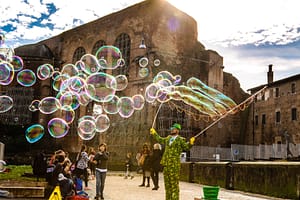Colosseum
As the Eiffel Tower is to Paris, the silhouette of the Flavian Amphitheatre is to Rome. The largest structure left to us by Roman antiquity, the Colosseum still provides the model for sports arenas – present day football stadium design is clearly based on this oval Roman plan. The building was begun by Vespasian in AD 72, and after his son Titus enlarged it by adding the fourth story, it was inaugurated in the year AD 80 with a series of splendid games. The Colosseum was large enough for theatrical performances, festivals, circuses, or games, which the Imperial Court and high officials watched from the lowest level, aristocratic Roman families on the second, the populace on the third and fourth.
VATICAN CITY & St. Peter’s Basilica
The Vatican is the smallest independent state in the world, with an area of less than half a square kilometer, most of it enclosed by the Vatican walls. Inside are the Vatican palace and gardens, St. Peter’s Basilica, and St. Peter’s Square, an area ruled by the Pope, supreme head of the Roman Catholic Church. This compact space offers much for tourists to see, between its museums and the great basilica itself.
Inside St. Peter’s Basilica is Michelangelo’s masterpiece, Pieta, along with statuary and altars by Bernini and others. The unquestioned highlight of the Vatican museums is the Sistine Chapel, whose magnificent frescoed ceiling is Michelangelo’s most famous work. Inside the Vatican Palace are the Raphael Rooms, the Borgia Apartments, the Vatican Library, and a number of museums that include the Picture Gallery, Museum of Secular Art, Etruscan Museum, and others. The collections you can see in these cover everything from papal coaches to 20th-century art reflecting religious themes.
Trevi Fountain
One of the city’s most popular tourist attractions, this 17th-century masterpiece has been immortalized in films until it is almost a required visit. Throwing a coin (not three) into the Trevi Fountain (Fontana di Trevi) is a tradition that is supposed to assure your return to Rome. Rome’s largest fountain, Fontana di Trevi is supplied by an aqueduct originally constructed by Agrippa, the great art patron of the first century BC, to bring water to his baths. The fountain was created for Pope Clement XII between 1732 and 1751 by Nicolò Salvi, and built against the rear wall of the palace of the Dukes of Poli. It depicts the sea god Oceanus (Neptune), with horses, tritons, and shells. The water swirls around the figures and the artificial rocks, and collects in a large basin, always filled with coins.
The Pantheon
The best preserved monument of Roman antiquity – is remarkably intact for its 2000 years. This is despite the fact that Pope Gregory III removed the gilded bronze roof tiles, and Pope Urban VIII ordered its bronze roof stripped and melted down to cast the canopy over the altar in St. Peter’s and cannons for Castel Sant’Angelo. The Pantheon was rebuilt after damage by fire in AD 80, and the resulting brickwork shows the extraordinarily high technical mastery of Roman builders. Its 43-meter dome, the supreme achievement of Roman interior architecture, hangs suspended without visible supports – these are well hidden inside the walls – and its nine-meter central opening is the building’s only light source. The harmonious effect of the interior is a result of its proportions: the height is the same as the diameter. Although the first Christian emperors forbade using this pagan temple for worship, in 609 Pope Boniface IV dedicated it to the Virgin and all the Christian martyrs, and since then, it has become the burial place of Italian kings (Victor Emmanuel II is in the second niche on the right) and other famous Italians, including the painter Raphael.
Roman Forum
Walking through the forum, now in the middle of a throbbing modern city, is like stepping back two millennia into the heart of ancient Rome. Although what survives of this center of Roman life and government shows only a small fraction of its original splendor, the standing and fallen columns, its triumphal arches, and remains of its walls still impress, especially when you consider that for centuries, the history of the Forum was the history of the Roman Empire and of the western world. Roman political and religious life was centered here, along with the courts, markets, and meeting places. After the seventh century, the buildings fell into ruin, and churches and fortresses were built amid the ancient remains. Its stones were quarried for other buildings and it was not until the 18th and 19th centuries that systematic excavations brought the ancient buildings to light from under a 10-meter layer of earth and rubble. Highlights not to miss are the Temple of Antoninus Pius, the Temple of Castor and Pollux, the Temple of Saturn, the Arch of Septimus Severus, the Curia, the Temple of Vesta, and the Arch of Titus.

